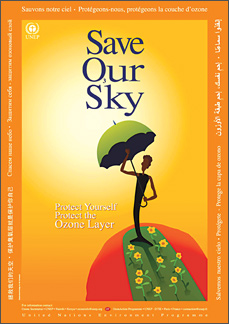|
International Day for the Preservation of the Ozone
Layer falls tomorrow:
Saving sky: saving yourself!
The Antarctic ozone hole is still
being widened. The average area of the ozone hole was at 10.6 million
square miles in 2006. The blue and purple colors are where there is the
least ozone, and the greens, yellows, and reds are where there is more
ozone. Photo courtesy; NASA
If you ask European tourists visiting this country reasons for their
visits, most of them would say that it is the sun and the beaches. For
the south Asians, definitely the tropical sun is a blessing but for some
prolonging droughts. Farmers, workers and school children tend to spend
more time outside exposed to the sun.
 But
according to the World Health Organization (WHO) prolonged exposure to
sunlight would lead to skin cancers and cataracts. The thinning of the
Ozone layer some 17 km above the ground has now made it possible to let
more ultra violet (UV) rays produced by the sun to reach the earth. But
according to the World Health Organization (WHO) prolonged exposure to
sunlight would lead to skin cancers and cataracts. The thinning of the
Ozone layer some 17 km above the ground has now made it possible to let
more ultra violet (UV) rays produced by the sun to reach the earth.
A WHO report states that around 66 000 deaths occur annually from
melanoma and other skin cancers while more than two million new cases of
non-malignant melanomas or skin diseases and more than 130 000 new
melanoma skin cancer cases are reported worldwide annually.
The people around world especially those who live in colder countries
naturally tend to seek more and more sun and as there is an increased
risk of developing health complications from over-exposure to UV
radiation. The WHO considers it as a substantial health concern.
The WHO warns that the effects of the exposure often do not appear
quickly but until many years later and as a result people are often
unaware of the health risks. The WHO also warns that the over-exposure
to the sun poses a risk to people of all colours, not only for the
fair-skinned.
Commenting to a newspaper on the health concerns to the Sri Lankans
country’s National Ozone Unit Director W.L. Sumathipala said that the
population and the biodiversity in Sri Lanka have adapted in ways like
having a dark skin colour to tackle the harmful UV rays. Sumathipala
said that the ozone layer above Sri Lanka too thinning; however said
that it has both negative aspects.
|

“Save Our Sky.” Another public awareness creating poster on the
importance of the protecting the ozone layer as well as
individual protection from sunlight. |
He pointed out that Sri Lanka with its proximity to the equator gets
direct sunlight throughout the year which could be harmful. However, Sri
Lanka does not experience changes in the seasons, so that the
inhabitants could have easily adapted to the prevailing climatic
condition.
Sumapthipala also emphasized the need to phase out the two chemicals
and one is Methyl Bromde which is used in the garment industry as a
bleaching agent. Another chemical used in firefighting is also harmful
to the ozone layer, he said. He said that although recent scientific
findings have shown that the ozone layer is recovering, the world must
be vigilant.
UNEP also states that the phase-out of Methyl Bromide, combating the
illegal trade in CFCs and full implementation of the Montreal Protocol
in developing countries are issues that need to be tackled. UNEP also
stressed the need to reduce over-exposure of children and adolescents to
the sun, in order to substantially reduce the risk of contracting skin
cancers, cataracts and other conditions which might only appear much
later in life.
UNEP says that mostly persons below the age of 18 tend to expose to
the sunlight and persons of these age groups should be educated about
the dangers of UV exposure.
According to the WHO though most of the known melanomas occur in the
industrialized world, it does not imply that the fair-skinned
populations are affected by UV radiation.
The WHO is of the view that if enough reporting mechanisms are in
place, it would reveal more melanoma cases originating in developing
countries as well. It is also pointed out that cataract susceptibility
by no means is connected to the colour of the skin, and people living
close to the equator are most likely to be affected.However, the WHO
advises that a moderate degree of UV exposure is necessary for the
production of Vitamin D which is essential for bone health. It also
points out that low Vitamin D levels could lead to other chronic
diseases. Thus, it is clear that striking a balance in moderate exposure
to the sun is vital. |



